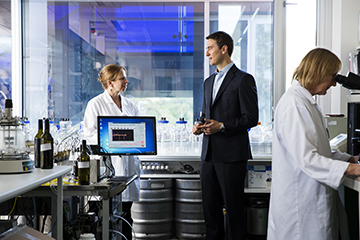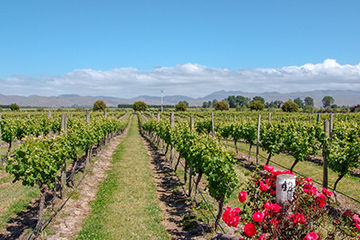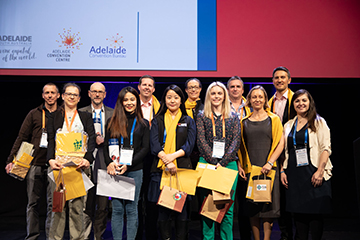Dr Dan Johnson, the Managing Director of The Australian Wine Research Institute, is leaving to take up a new appointment as Pro Vice Chancellor Research Innovation at Macquarie University. The move was announced today by the AWRI’s Chair, Louisa Rose. Dr Johnson will take up his new position in February 2020.
The Australian Wine Research Institute Blog
eNews – September 2019
19 September 2019 >Sustainable Winegrowing Australia update
Major grant to bring EU researchers to the AWRI
Advanced Viticulture Course launching in October
Manufacturing modernisation grants
Order the latest AWRI staff publications online
New infrastructure funding |
|
 |
The AWRI has secured a major infrastructure funding boost from a combination of Federal and State Government sources. Bioplatforms Australia, which manages investment funding through the Australian Government’s National Collaborative Research Infrastructure Strategy (NCRIS), together with the South Australian Government and the AWRI will collectively invest $11.1m for metabolomics and associated activities at the AWRI from 1 July 2019 to 30 June 2023.
This significant investment builds on the success of the AWRI’s existing metabolomics facility, which was established in 2008 with support from Bioplatforms Australia and the South Australian Government. The facility supports local and national researchers and industries through the development and provision of metabolomic analysis. It operates as a collaborative service platform, providing access to infrastructure and specialist expertise to academia and industry across all interested sectors. Metabolomics is the comprehensive analysis of the complete set of all low molecular weight metabolites (the metabolome) that exist within a biological system such as grape juice, yeast or wine. The metabolome consists of hundreds to thousands of molecules with widely varied chemical and physical properties. Metabolomics gives scientists the ability to look at things from a ‘global’ perspective; to see the bigger picture of what happens during biological processes such as fermentation. |
Sustainable Winegrowing Australia updateMembership of Sustainable Winegrowing Australia opened on 1 July and an official launch event was held in Adelaide during the AWITC. With the integration of Entwine and SAW members into a single, united national program, Sustainable Winegrowing Australia now has more than 600 active members across 43 wine regions. Since the opening, new vineyard and winery members from across Australia have also joined. Detailed information about Sustainable Winegrowing Australia is available on the AWRI website. If you are interested in joining the program, everything you need to get started can be found in the Program Guide and User Manual. If you are a member and have not yet completed the membership renewal/workbook information for 2019/20, please log in to the Sustainable Winegrowing Australia website now to do so. Renewing your membership now will ensure you receive a complete benchmarking report in October. For any queries about the program, contact the AWRI helpdesk on 08 8 313 6600 or helpdesk@awri.com.au. |
|
17th AWITC wrap-up |
|
 |
A positive and well-attended Australian Wine Industry Technical Conference was held in Adelaide in late July. By the time the conference closed on the afternoon of Wednesday 24 July, well over 3,000 attendees had engaged with the event in some way. AWRI staff were involved across all aspects of the AWITC and have been very pleased with the positive feedback that has been received. Webcasts of the plenary sessions are currently available to delegates (via a link that was distributed by email) and will be made available to non-delegates after 1 November. Preparation of the conference proceedings is in progress, and planning for the 18th AWITC commenced at a debrief meeting earlier this month. |
Major grant to bring EU researchers to the AWRIA new grant awarded to the Oenoviti International network of grape and wine research organisations will fund EU researchers to spend time on sabbatical at the AWRI. These placements will benefit the Australian wine industry through enhanced collaborative networks, knowledge sharing and personal relationships within the international grape and wine research community. The successful funding application was made jointly by thirteen partner organisations (including the AWRI) that are members of the Oenoviti International network. Around 11 EU researchers from France, Portugal and Spain are expected to spend time at the AWRI across 2019 to 2023 as part of this international exchange program. AWRI scientists are looking forward to sharing their knowledge and learning from the high-calibre visiting researchers. |
|
Advanced Viticulture Course launching in October |
|
 |
The AWRI is presenting a new intensive three-day course in October on the latest techniques and technologies in viticulture. Participants will travel in a small group across four SA regions to visit sites and meet practitioners who are at the cutting-edge of Australian viticulture. The course is aimed at practising viticulturists with an interest in innovation and is limited to 20 participants to ensure an intensive and interactive learning experience. This year’s course has sold out; however, expressions of interest in future courses are now being taken. Visit the course page to find out more and register your interest. |
Manufacturing modernisation grantsA Manufacturing Modernisation Fund has recently been announced by the Australian Government. This fund will support manufacturers to modernise, adopt new technologies, become more productive and create jobs by co-funding capital investments and associated reskilling. The program will run over three years and will be delivered through two streams of funding:
Applications for grants under this program, run by the Australian Government Department of Industry, Innovation and Science, close 31 October 2019. Full details can be found here. This fund is one example of the many grant programs offered by different levels of government in Australia that may be applicable to grapegrowing and winemaking businesses. A regularly updated summary of relevant grant programs is provided on the AWRI website. |
|
Awards and achievements |
|
 |
Congratulations are due to a number of AWRI staff for achievements over recent months. At the Oeno 2019/In Vino Analytical Scientia Conference in Bordeaux in late June, Yevgeniya Grebneva was awarded the first Denis Dubourdieu award for an outstanding presentation by a young researcher. At the AWITC in July, Mango Parker, Eleanor Bilogrevic, Martin Day and Caroline Bartel were all awarded prizes for their posters – with Eleanor winning both a judges’ prize and the people’s choice! Caroline also won one of the two prizes for the Fresh Science presentations in the plenary program and Mango also won the judges’ prize in the student forum ‘In the Wine Light’ for a 3-minute explanation of her PhD research. And, to top off an incredible year, Mango was named one of three finalists in the Researcher/Innovator category of the Australian Women in Wine Awards. Congratulations to all of these high achievers! |
Order the latest AWRI staff publications onlineAccessing the latest AWRI publications is easy. Visit the AWRI Publications web page to:
The AWRI’s most recent publications are listed below. 2095 Mierczynska-Vasilev, A., Wahono, S.K., Smith, P.A., Bindon, K., Vasilev, K. Using Zeolites to protein stabilize white wines. ACS Sustainable Chem. Eng. DOI: 10.1021/acssuschemeng.9b01583: 1-8; 2019. 2096 Wilkes, E., Newell, B., Johnson, D. Wine storage temperature – investigating the impact of small differences. Wine Vitic. J. 34(3): 27-29; 2019. 2097 Dry, P. Clairette. Wine Vitic. J. 34(3): p. 53; 2019. 2098 Teng, B., Hayasaka, Y., Smith, P.A., Bindon, K.A. Effect of grape seed and skin tannin molecular mass and composition on the rate of reaction with anthocyanin and subsequent formation of polymeric pigments in the presence of acetaldehyde. J. Agric. Food Chem. 67(32): 8938-8949; 2019. 2099 Canonico, L., Solomon, M., Comitini, F. Ciani, M., Varela, C. Volatile profile of reduced alcohol wines fermented with selected non-Saccharomyces yeasts under different aeration conditions. Food Microbiol. 84(103247): 1-8; 2019. 2100 Hoare, T. Ask the AWRI: Controlling vineyard weeds. Aust. N.Z. Grapegrower Winemaker (666): 43-44; 2019. 2101 Gupta, V.V.S.R., Bramley, R.G.V., Greenfield, P., Yu, J., Herderich, M.J. Vineyard soil microbiome composition related to rotundone concentration in Australian cool climate ‘peppery’ Shiraz grapes. Front. Microbiol. 10(1607): 1-19; 2019. 2102 Simos, C. Tech-led evolution of wine shows. WBM (July/August): p. 30; 2019. 2103 Kassara, S., Li, S., Smith, P., Blando, F., Bindon, K. Pectolytic enzyme reduces the concentration of colloidal particles in wine due to changes in polysaccharide structure and aggregation properties. Int. J. Biol. Macromol. DOI:10.1016/j.ijbiomac.2019.08.043: 1-39; 2019. 2104 Grebneva, Y., Bellon, J.R., Herderich, M.J., Rauhut, D., Stoll, M., Hixson, J.L. Understanding yeast impact on 1,1,6-Trimethyl-1,2-dihydronaphthalene formation in Riesling wine through a formation-pathway-informed hydrolytic assay. J. Agric. Food Chem. DOI:10.1021/acs.jafc.9b03228: 9 p.; 2019. 2105 Coulter, A. Ask the AWRI: Spoilage issues in Pinot Noir. Aust. N.Z. Grapegrower Winemaker (667): 68-69; 2019. 2106 Clarke, C.W., Norng, S., Carmody, B.M., Yuanpeng, D., Powell, K.S. Hot water immersion as a disinfestation treatment for grapevine root cutting against genetically diverse grape phylloxera Daktulophaira vitifoliae Fitch. Aust. J. Grape Wine Res. DOI:10.1111/ajgw.12407: 1-8; 2019. 2107 Visalakshan, R.M., MacGregor, M.N., Sasidharan, S., Ghazaryan, A., Mierczynska-Vasilev, A.M., Morsbach, A., Mailänder. V., Landfester, K., Hayball, J.D., Vasilev, K. Biomaterial surface hydrophobicity-mediated serum protein adsorption and immune responses. ACS Appl. Mater. Interfaces 11(31): 27615-27623; 2019. 2108 Ghaemi, S.R., Delalat, B., Cavallaro, A., Mierczynska-Vasilev, A., Vasilev, K., Voelcker, N.H. Differentiation of rat Mesenchymal stem cells towards osteogenic lineage on extracellular matrix protein gradients. Adv. Healthcare Mater. DOI:10.1002/adhm.201900595: 1-11; 2019. |
|
AcknowledgementsThe AWRI acknowledges support from Australia’s grapegrowers and winemakers through their investment body, Wine Australia, with matching funds from the Australian Government. The AWRI is a member of the Wine Innovation Cluster in Adelaide, South Australia. |
|
Skilled taster awarded wine judging opportunity
17 September 2019 >The Australian Wine Research Institute (AWRI) announced this week that Sam Leyshon, from Mallaluka Wines in the Canberra District, was the dux of the 44th Advanced Wine Assessment Course.
Regulatory changes to the use of botrytis agrochemical
13 September 2019 >Read the latest Ask the AWRI article.
A recent AWRI eBulletin cautioned wine exporters about shipments to the European Union after a change in the residue tolerance for the agrochemical iprodione – the active constituent in some agrochemicals used to control botrytis. It was recommended that wines be residue tested prior to shipment. The AWRl’s Marcel Essling answers some probing questions into the implications of the regulatory changes for this agrochemical.
Major grant supports international grape and wine researcher exchange
4 September 2019 >A consortium of members of the Oenoviti International network of grape and wine research organisations has received a major EU-sponsored grant for international researcher exchange. Thirty-nine grape and wine researchers from the EU will be funded to spend time on sabbatical at either industry organisations in the EU or at relevant research institutions in New World wine-producing companies, thanks to the more than EUR 874,000 grant from the EU.
$11 million in new infrastructure funding to boost Adelaide research facility
3 September 2019 >The Australian Wine Research Institute (AWRI) in Adelaide has secured a major infrastructure funding boost from a combination of Federal and State Government sources. Bioplatforms Australia, which manages investment funding through the Australian Government’s National Collaborative Research Infrastructure Strategy (NCRIS), together with the South Australian Government and the AWRI will collectively invest $11.1m for metabolomics and associated activities at the AWRI from 1 July 2019 to 30 June 2023.
4 new AWRI webinars – registration is open now!
2 September 2019 >
Starting 5 September, the Bureau of Meteorology will showcase a new 7-day frost warning tool and discuss frost risk for the season ahead. The following three webinars address weed control, vineyard mapping and maceration techniques to tailor wine style.
See the full program here.
Each webinar includes a presentation and an opportunity for audience members to ask questions and is usually held on a Thursday at 11:30 am Australian Central Daylight Time (Adelaide, GMT+09:30). All AWRI webinars are free to attend.
The next four webinars for the program are:
5 September 2019: Bureau of Meteorology frost risk outlook and frost warning service – Darren Ray & Naomi Benger (BOM)
19 September 2019: How weeds influence a vineyard – Tony Hoare (AWRI)
26 September 2019: GAIA – a new app to locate vineyards, store information and monitor crop health – Sandy Hathaway (Wine Australia)
3 October 2019: Using maceration techniques to tailor red wine styles – Dr Keren Bindon (AWRI)
System requirements
You will need a computer or mobile device with an internet connection. Audio is connected over the internet using your computer or mobile device’s speakers (Voice over Internet Protocol – VOIP). Participants joining a webinar via a mobile device will need to download a free app available from iTunes or Google Play.
If you’ve missed a previous AWRI webinar, you can watch online via the AWRI’s YouTube channel.
For further information on AWRI webinars, please contact the AWRI information services team.
Agrochemical update
23 August 2019 >New withholding period
The Australian Pesticides and Veterinary Medicines Authority (APVMA) has recently approved a new maximum residue limit (MRL) for difenoconazole in grapes and a new label withholding period. The ‘Dog book’ recommendation for difenoconazole (Digger) use on grapes destined for export wine is ‘Use no later than E-L 29, berries pepper-corn size (not > 4 mm diameter)’. The label withholding period is 28 days. It is recommended that you check your winery or grape purchaser’s restriction on use for difenoconazole prior to application.
New formulation and target
POTASSIUM BICARBONATE AND POTASSIUM SILICATE
APVMA 83204
‘EcoCarb Plus’ is an Organic Crop Protectants Pty Ltd product.
‘EcoCarb Plus’ is registered for control of powdery mildew and suppression of downy mildew in grapevines. It is an activity group M2 fungicide.
Recommended restriction on use (withholding period) for grapes destined for export wine: Use no later than 7 days before harvest.
Powdery mildew resistance management strategy
CropLife Australia has updated the resistance management strategy for powdery mildew. The new strategy clarifies the requirements around consecutive applications of Group 7 and 11 fungicides. Group 7 and 11 fungicides should only be applied consecutively when used in a mixture or co-formulated with a registered, alternative mode of action for which resistance is not known. The new strategy can be found on page 19 of the ‘Dog book’ pdf.
Prosper 500 EC re-entry period
The re-entry period for powdery mildew fungicide spiroxamine (Prosper 500 EC) has changed and now includes re-entry periods for certain unprotected work activities in grapevines. Some of these re-entry requirements, where personal protective equipment (PPE) is not worn, are of significant length and need to be considered as part of the planning for post-spraying farming activities.
The revised re-entry period statement on the Prosper label (where PPE is not worn):
For treated grapevines, do not allow entry into treated areas for the following times to conduct the stated activities:
- Transplanting, hand weeding, hand pruning, trellis repair, bird control, propagating and scouting: Do not allow entry into treated areas until the spray has dried.
- Tying/training, leaf pulling, hand harvesting: 11 days
- Girdling (cincturing), bunch turning: 16 days
The specific PPE required for workers to undertake these tasks prior to the re-entry periods stipulated is cotton overalls buttoned to the neck and wrist (or equivalent clothing) and gauntlet-length chemical-resistant gloves.
The ‘Dog book’ resources available online including the pdf and search facility have been updated to reflect the changes listed in this eBulletin. The app will be updated on 26 August. Users of agrochemicals are reminded to read and follow all label directions.
For more information, please contact Marcel Essling on 08 8313 6600 or email helpdesk@awri.com.au.
This information is provided to inform the Australian grape and wine sector and should not be interpreted as an endorsement of any product.
Spoilage issues in Pinot Noir
21 August 2019 >Read the latest Ask the AWRI article.
During the 1990s, a high number of the microbiological instability issues investigated by the AWRI’s helpdesk were associated with bottled Pinot Noir wines (Bruer et al. 1998). Looking at today’s stats, Pinot Noir wines still represent a significant proportion of the microbiological spoilage issues submitted to the helpdesk. In this article Adrian Coulter presents answers to common questions about microbial spoilage in Pinot Noir.
Technical Review August 2019 issue available online
>| AWRI Technical Notes | |
| AWRI publications |
|
| Current literature – oenology |
|
| Current literature – viticulture |
|

